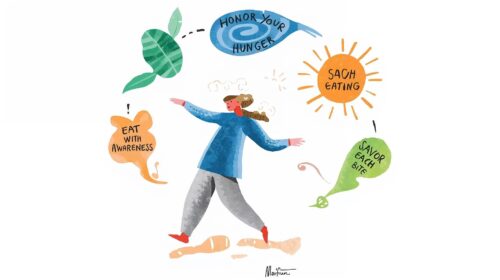If the holidays had a personality, it would be a charming gremlin handing you a cookie in one hand and your calendar in the other. Which is why mindful eating isn’t something to “try in December.” We are officially 6 weeks out, so tt’s a skill you practice now—so it’s there for you when the food and drink start to flow. Remember!! Consistency beats intensity. Tiny reps today become sustainable habits tomorrow.
Why practice before the holidays?
- Habits harden under pressure. When stress increases, we tend to default to what’s familiar – especially when we are around family and friends where mindfulness might not be the norm. If mindful pauses and check-ins are already part of your routine, you’ll lean on them naturally when things get hectic.
- Mindful skill- sets. Like strength training, small sets—three breaths, a hunger check, a 50% pause—build capacity over time. By mid-December, you’re not “trying to be mindful”; you’re simply being you.
- Sustainable, not seasonal. Practicing now reframes mindful eating as an all-year wellbeing skill, not a holiday damage-control tactic. That shift keeps you out of the all-or-nothing spiral.
- Evidence supports mindfulness-based approaches for reducing emotional and binge eating, improving self-regulation, and increasing satisfaction with food—especially useful in high-stimulus seasons (see sources).
The “Practice Now” Technique
- Three-Breath Ritual: Before any meal or snack, pause for three slow breaths. If you forget beforehand, do it after the first bite. You’re training the pause, not perfection.
- Two-Number Check-In: Rate physical hunger (0–10) and emotion/stress (0–10). If hunger < 4 and stress > 6, try a non-food soothe first: 2 minutes of box breathing, a brisk block walk, or a quick text to a friend.
- First-Bite Scan: Notice flavor, texture, temperature, and satisfaction. If it’s a 6/10, decide whether to continue, swap, or save. If it’s a 10/10, enjoy—slowly.
- The 50% Pause: Halfway through, set utensils down. Ask: Am I still enjoying this? What’s the next best bite? Continue, slow, or wrap.
- Plate It: Even snacks. Containers = autopilot. Plates create a beginning, middle, and end.
Do these once a day for a week. In week two, aim for two meals a day. Keep it light, kind, and repeatable.
Build sustainable meals and times
- Home-Base Breakfast: Pick one steady breakfast (protein + fiber + fat) you actually like. Practice it on weekdays so it’s automatic when mornings get busy.
- Anchor Snack: Before events or errands, have a protein + fiber snack (e.g., Greek yogurt + berries + nuts; hummus + veg; cheese + apple). This levels blood sugar so “future you” chooses calmly, not chaotically.
- Default Plate Visual: Picture half veg/fruit, quarter protein, quarter starch. It’s a guide, not a rule—you can still have the dip; the visual simply gives your plate a map.
- Savor-Once-a-Day: Choose one treat daily to sit and savor, screen-free. This counters the “last-supper” mindset that fuels overdoing.
Make eating an experience again
- Screens off for 5–10 minutes. Single-tasking improves recall of the meal and satisfaction.
- Sensory attention: Color, aroma, temperature, crunch/creaminess. Satisfaction climbs when your senses are engaged, often leading to comfortable stopping without white-knuckling (see sources).
- Set the table (a little). A napkin, a glass of water, a real plate. Small rituals signal “this matters.”
Compassion is your sustainability engine
You will have human moments. That’s not failure—that’s practice material. Swap self-critique for curiosity:
• Name it: “That was a lot, fast.”
• Normalize it: “Humans eat emotionally sometimes.”
• Nudge it: “What’s one kind next step?” Water, brief walk, brush teeth, make tea, write a two-sentence note about what you loved and what you’ll try next time.
Shame shuts learning down. Acceptance and kindness keeps the practice going.
A 5-minute pre-party practice flow
- Hydrate: One glass of water.
- Check-In: Hunger 0–10, Emotion 0–10.
- Intention: “I’ll savor my top two favorites and stop at comfortable.”
- Anchor Snack: Protein + fiber.
- Three Breaths: Before the first bite.
A 3-step post-party reset
- Close the Loop: Brush teeth or make tea to signal “kitchen closed.”
- Quick Reflect: What was worth it? What would I tweak next time?
- Protect Sleep: Tomorrow’s choices ride on tonight’s rest more than willpower.
These strategies are a great example of the Behavior Change process of finding Motivation (avoiding Holiday overindulgence-guilt cycle) Mastering the Mindfulness Skills (here in this article) for long-term Maintenance and results. For more support with this click here to book a complimentary Momentum Builder Call with me. Book Now
Sources
Katterman, S. N., Kleinman, B. M., Hood, M. M., Nackers, L. M., & Corsica, J. A. (2014). Mindfulness meditation as an intervention for binge eating, emotional eating, and weight loss: A systematic review. Eating Behaviors, 15(2), 197–204.
O’Reilly, G. A., Cook, L., Spruijt-Metz, D., & Black, D. S. (2014). Mindfulness-based interventions for obesity-related eating behaviours: A literature review. Obesity Reviews, 15(6), 453–461.
Kristeller, J. L., & Wolever, R. Q. (2011). Mindfulness-based eating awareness training for treating binge eating disorder: The conceptual foundation. Eating Disorders, 19(1), 49–61.
Robinson, E., Almiron-Roig, E., Rutters, F., et al. (2014). A systematic review and meta-analysis examining the effect of eating rate on energy intake and hunger. American Journal of Clinical Nutrition, 100(1), 123–151.




